Abstract
Three types of phospholipase activity--phospholipase A1, A2, and lysophospholipase--were detected in Mycobacterium leprae harvested from armadillo tissue at about 25% of the specific activity found in a slowly growing mycobacterium, Mycobacterium microti, which was grown in medium to optimize its phospholipase activity. The highest activity found was lysophospholipase, which released fatty acid from 2-lyso-phosphatidylcholine. Phospholipase activity was detected by using phosphatidylcholine and phosphatidylethanolamine. Differences in relative activities with these three types of substrate distinguished phospholipase activity in M. leprae extracts from armadillo liver extracts. Furthermore, retention of activity in M. leprae after NaOH treatment showed that the activity associated with M. leprae was not host derived. The specific activity of phospholipase was 20 times higher in extracts of M. leprae than in intact M. leprae organisms. Diazotization, a treatment which abolishes activities of surface enzymes exposed to the environment by the formation of covalent azide bonds with exposed amino groups, did not affect M. leprae's phospholipase activity, with one exception: release of arachidonic acid from phosphatidylcholine, which was partially inhibited. Phenolic glycolipid I, the major excreted amphipathic lipid of M. leprae, inhibited phospholipase activity, including release of arachidonic acid, for both M. leprae- and armadillo-derived activity.
Full text
PDF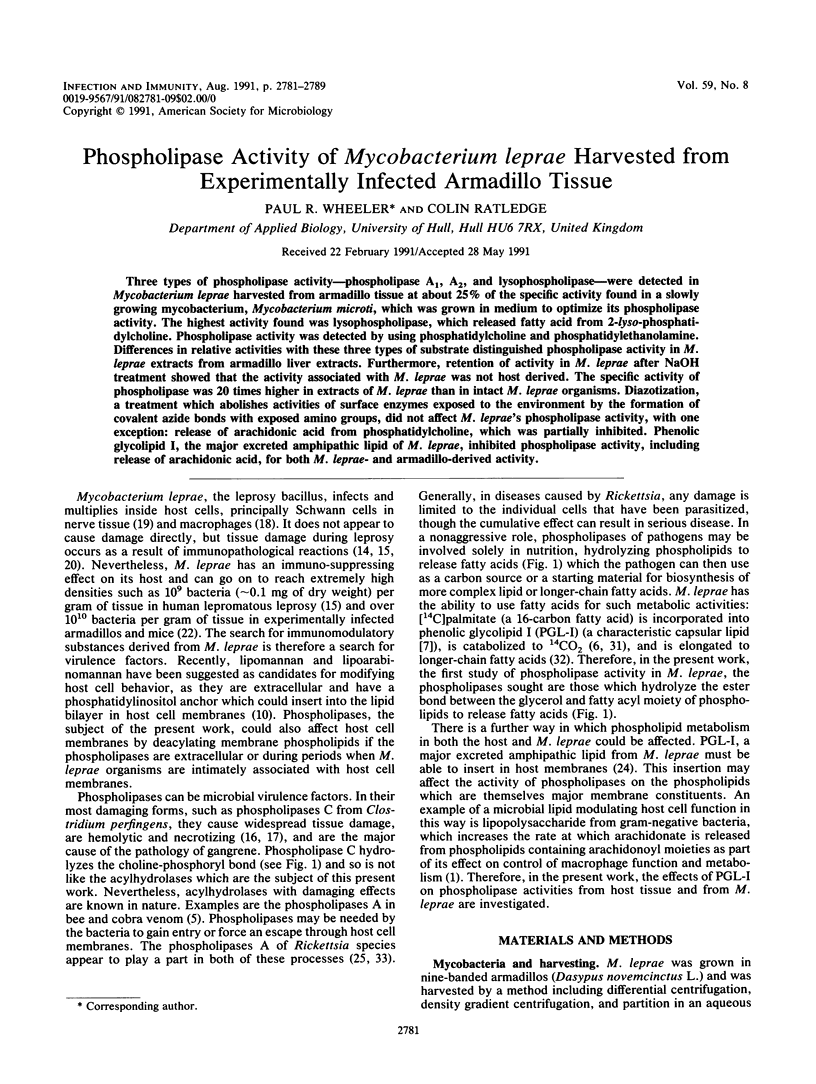
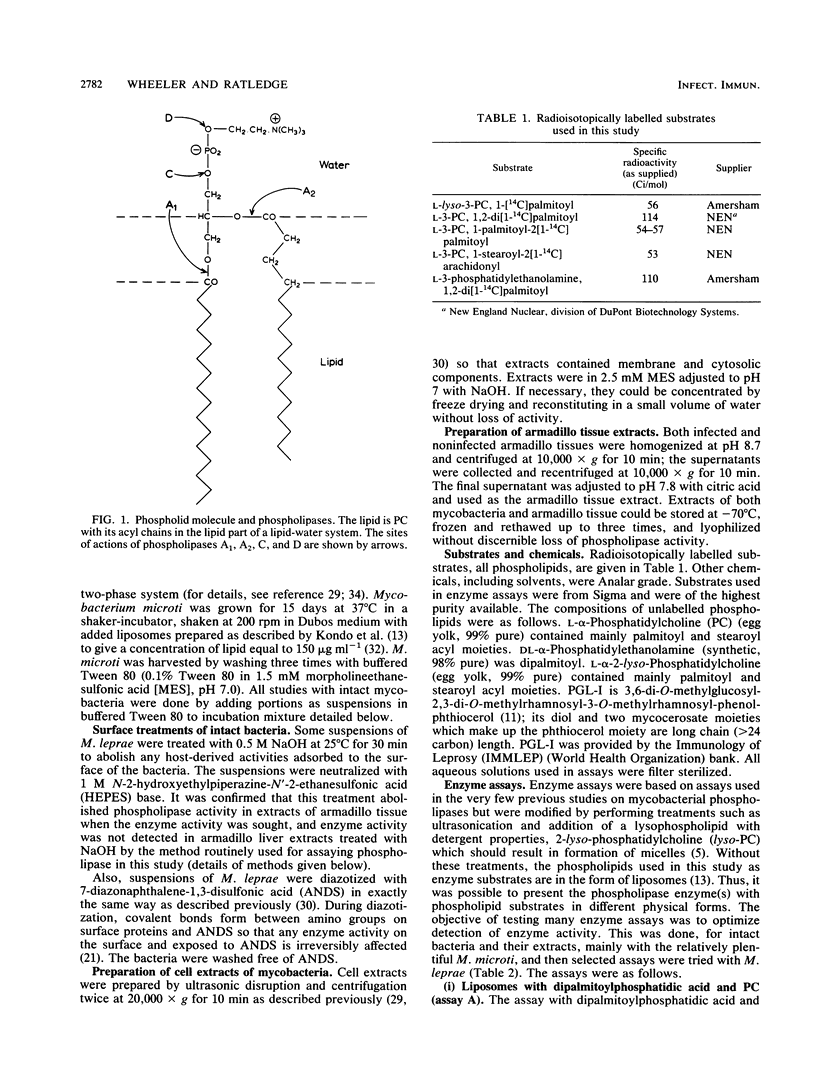
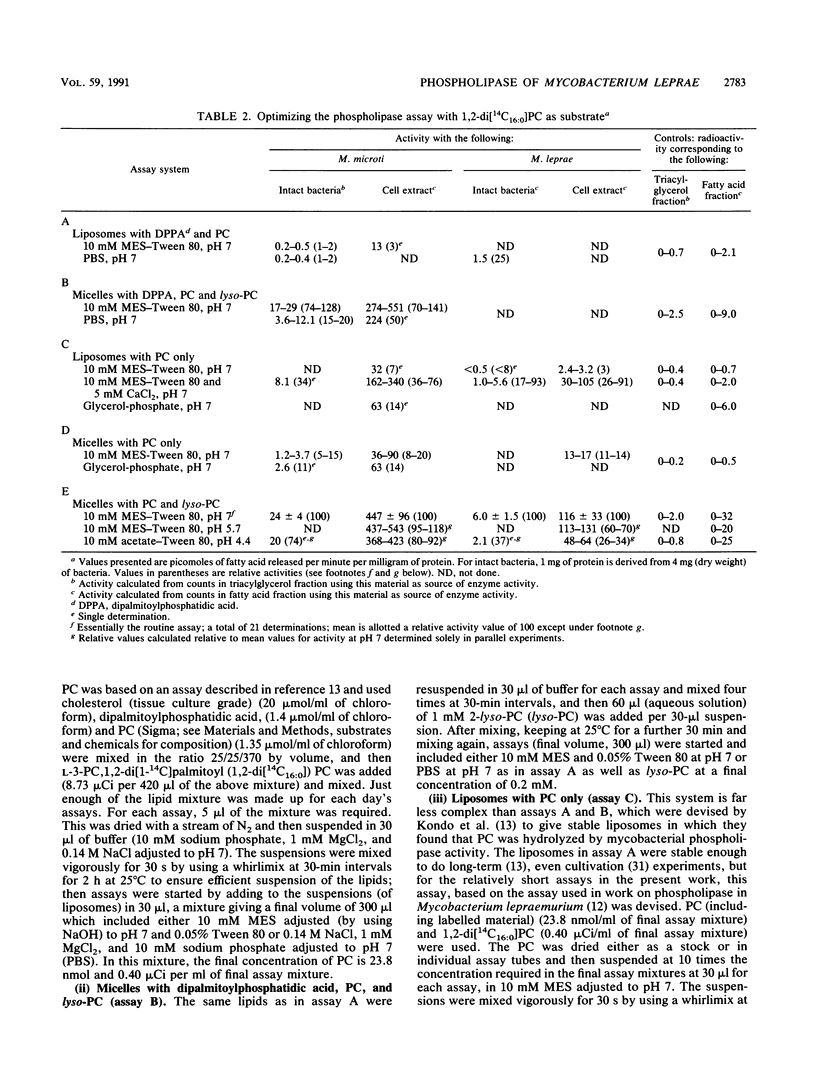
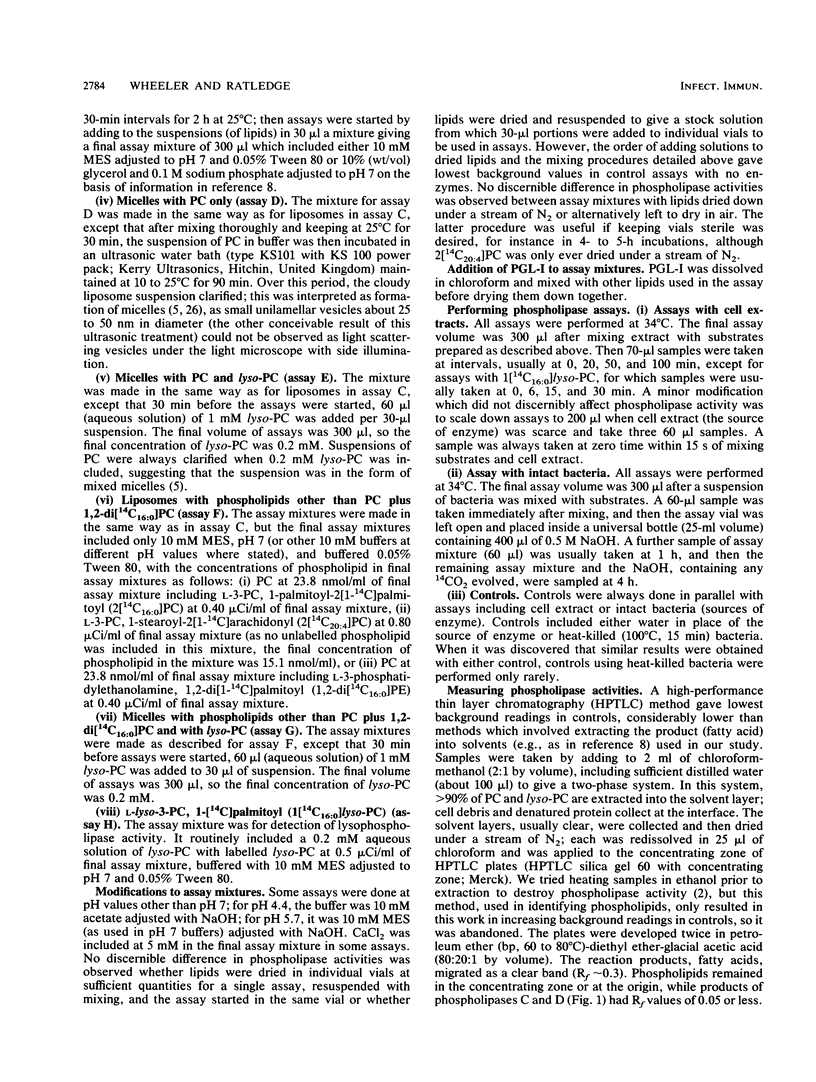
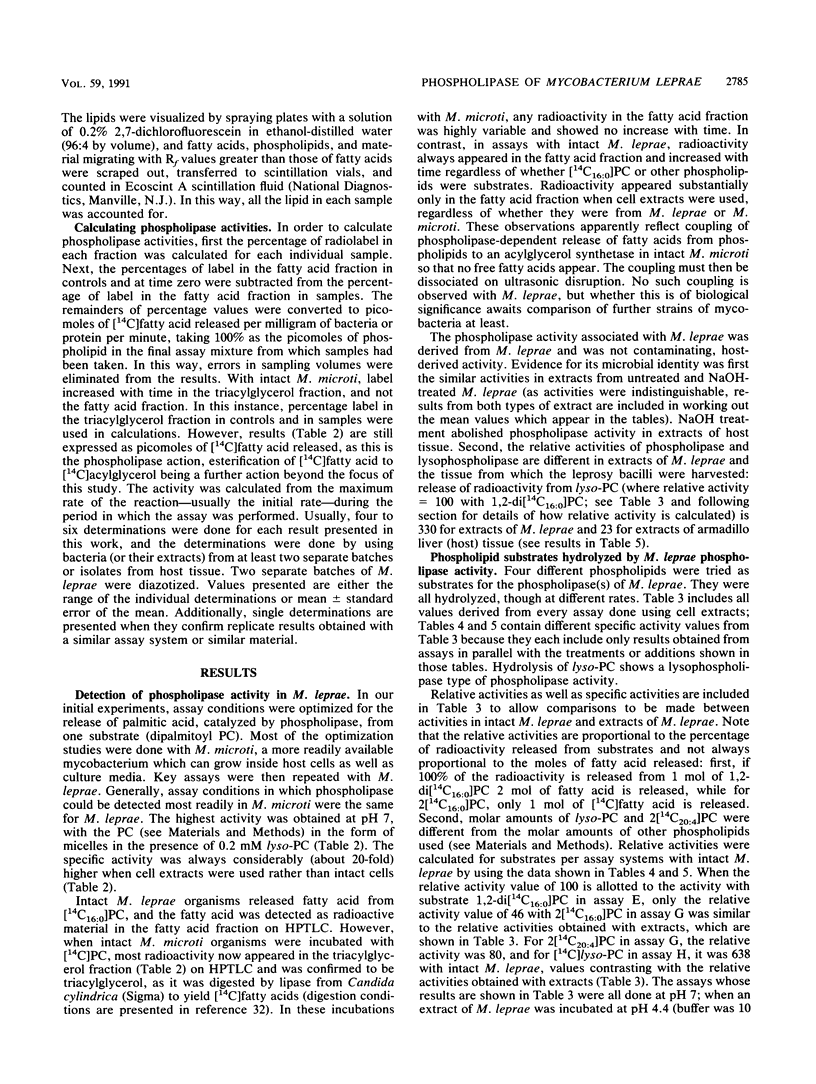
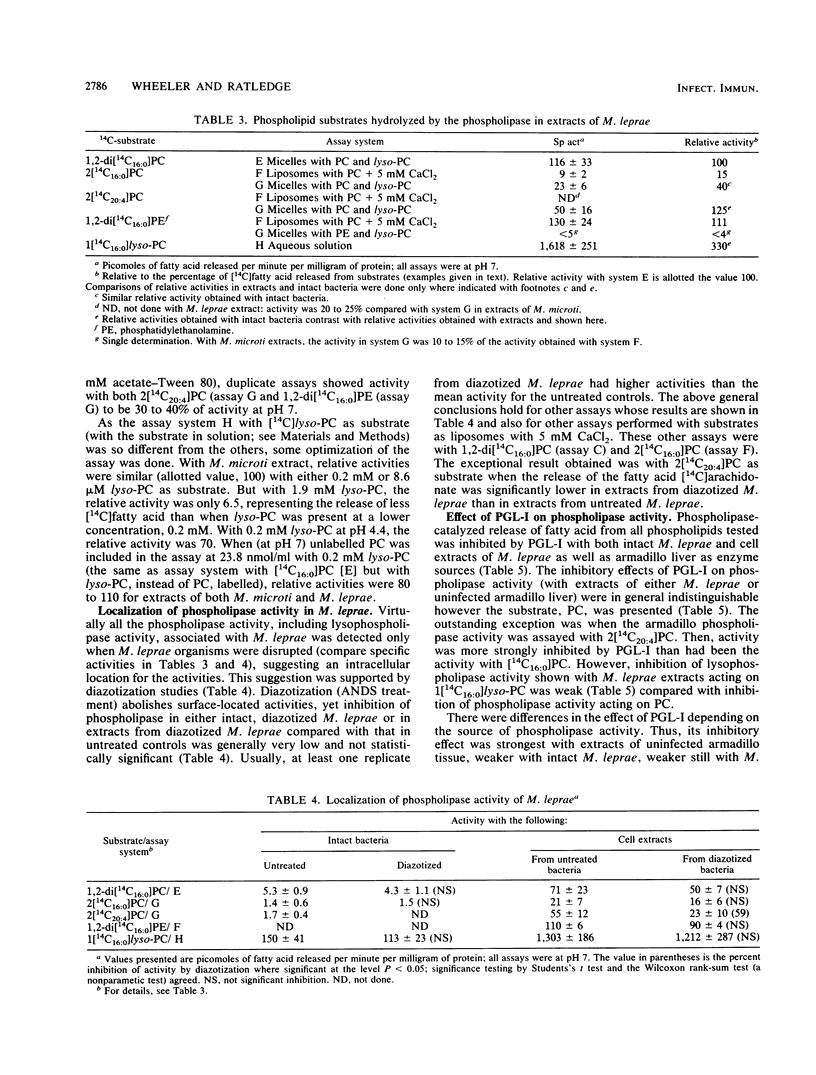
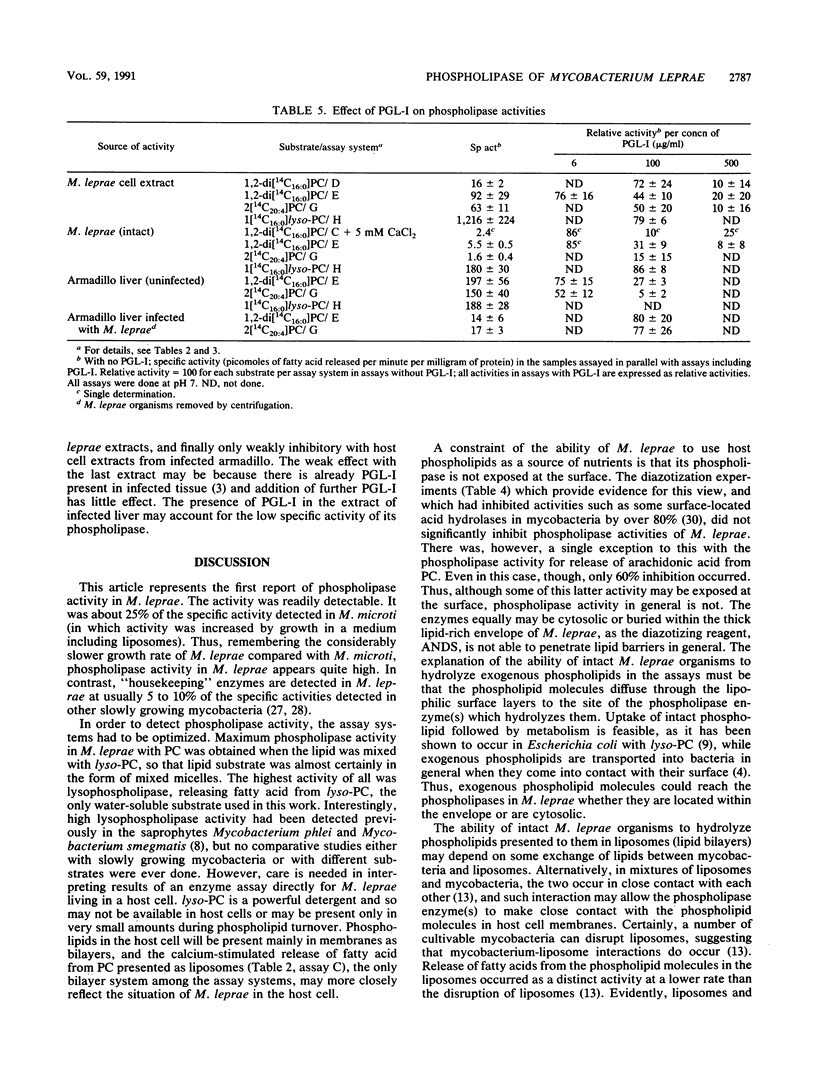
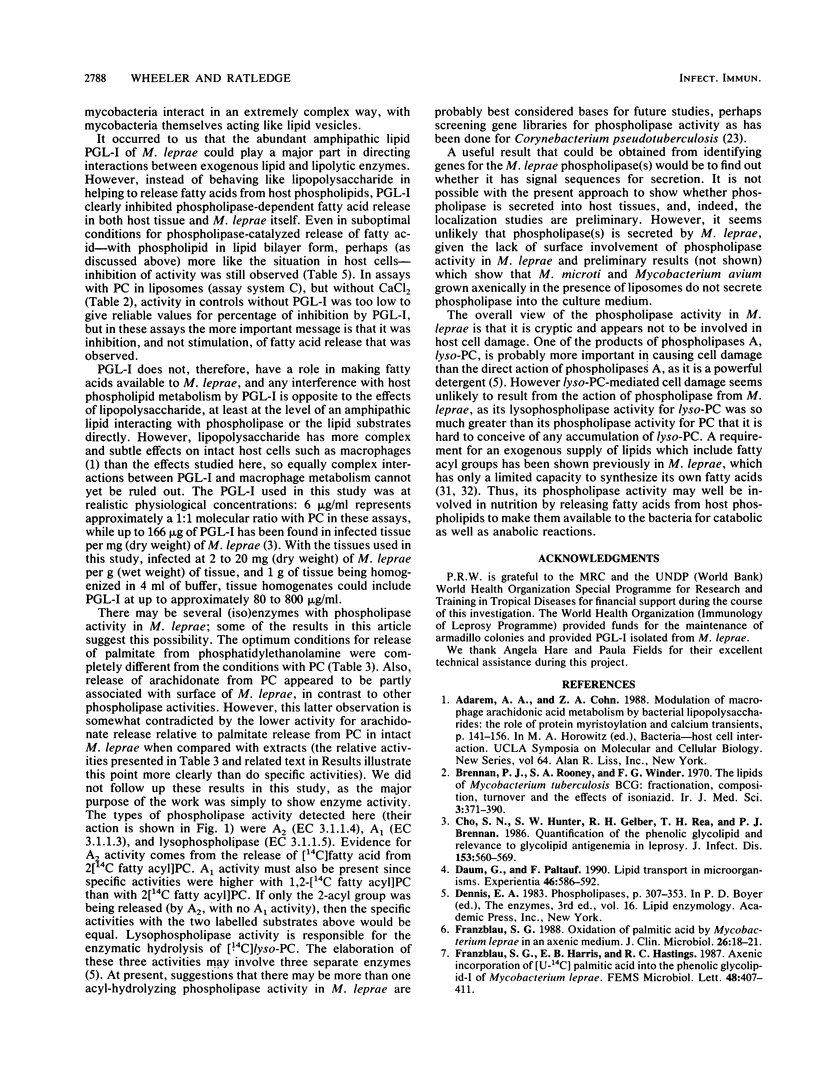
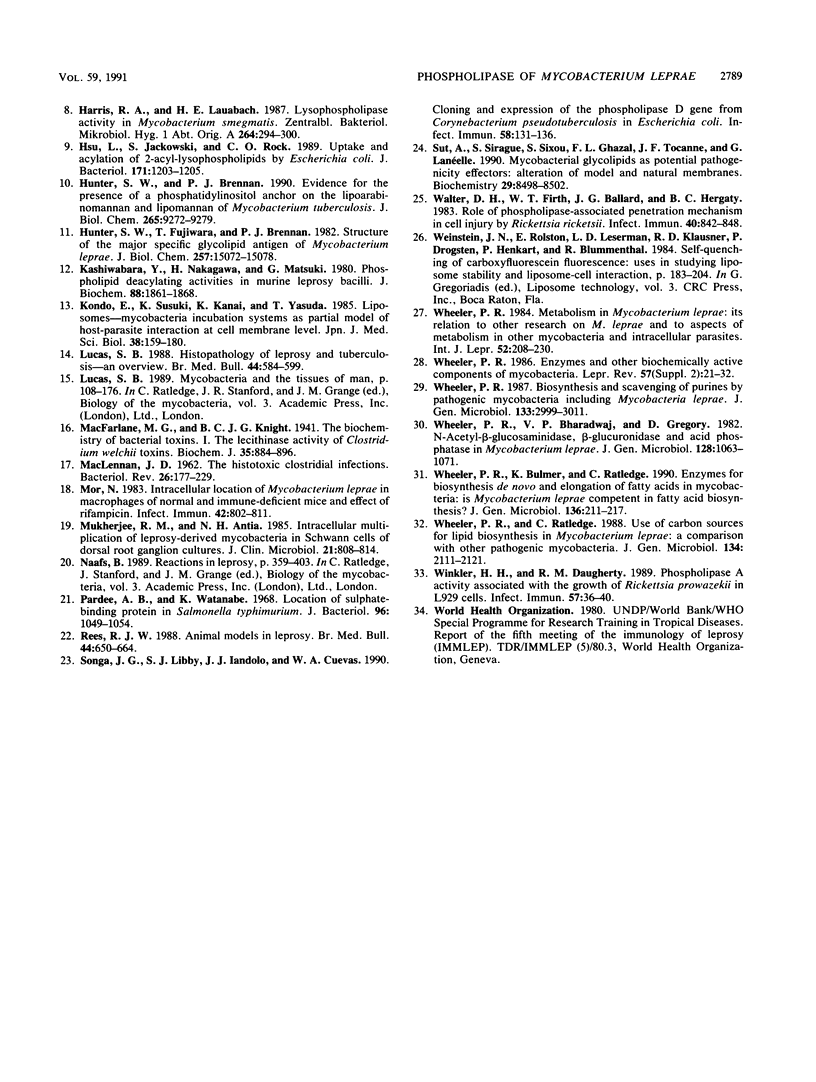
Selected References
These references are in PubMed. This may not be the complete list of references from this article.
- Brennan P. J., Rooney S. A., Winder F. G. The lipids of Mycobacterium tuberculosis BCG: fractionation, composition, turnover and the effects of isoniazid. Ir J Med Sci. 1970 Aug;3(8):371–390. doi: 10.1007/BF02956904. [DOI] [PubMed] [Google Scholar]
- Cho S. N., Hunter S. W., Gelber R. H., Rea T. H., Brennan P. J. Quantitation of the phenolic glycolipid of Mycobacterium leprae and relevance to glycolipid antigenemia in leprosy. J Infect Dis. 1986 Mar;153(3):560–569. doi: 10.1093/infdis/153.3.560. [DOI] [PubMed] [Google Scholar]
- Daum G., Paltauf F. Lipid transport in microorganisms. Experientia. 1990 Jun 15;46(6):586–592. doi: 10.1007/BF01939697. [DOI] [PubMed] [Google Scholar]
- Franzblau S. G. Oxidation of palmitic acid by Mycobacterium leprae in an axenic medium. J Clin Microbiol. 1988 Jan;26(1):18–21. doi: 10.1128/jcm.26.1.18-21.1988. [DOI] [PMC free article] [PubMed] [Google Scholar]
- Harris R. A., Laubach H. E. Lysophospholipase activity of Mycobacterium smegmatis. Zentralbl Bakteriol Mikrobiol Hyg A. 1987 May;264(3-4):294–300. doi: 10.1016/s0176-6724(87)80047-0. [DOI] [PubMed] [Google Scholar]
- Hsu L., Jackowski S., Rock C. O. Uptake and acylation of 2-acyl-lysophospholipids by Escherichia coli. J Bacteriol. 1989 Feb;171(2):1203–1205. doi: 10.1128/jb.171.2.1203-1205.1989. [DOI] [PMC free article] [PubMed] [Google Scholar]
- Hunter S. W., Brennan P. J. Evidence for the presence of a phosphatidylinositol anchor on the lipoarabinomannan and lipomannan of Mycobacterium tuberculosis. J Biol Chem. 1990 Jun 5;265(16):9272–9279. [PubMed] [Google Scholar]
- Hunter S. W., Fujiwara T., Brennan P. J. Structure and antigenicity of the major specific glycolipid antigen of Mycobacterium leprae. J Biol Chem. 1982 Dec 25;257(24):15072–15078. [PubMed] [Google Scholar]
- Kashiwabara Y., Nakagawa H., Matsuki G. Phospholipid deacylating activities in murine leprosy bacilli. J Biochem. 1980 Dec;88(6):1861–1868. [PubMed] [Google Scholar]
- Kondo E., Suzuki K., Kanai K., Yasuda T. Liposomes-mycobacteria incubation systems as a partial model of host-parasite interaction at cell membrane level. Jpn J Med Sci Biol. 1985 Aug;38(4):169–180. doi: 10.7883/yoken1952.38.169. [DOI] [PubMed] [Google Scholar]
- Lucas S. B. Histopathology of leprosy and tuberculosis--an overview. Br Med Bull. 1988 Jul;44(3):584–599. doi: 10.1093/oxfordjournals.bmb.a072269. [DOI] [PubMed] [Google Scholar]
- MACLENNAN J. D. The histotoxic clostridial infections of man. Bacteriol Rev. 1962 Jun;26:177–276. [PMC free article] [PubMed] [Google Scholar]
- Macfarlane M. G., Knight B. C. The biochemistry of bacterial toxins: The lecithinase activity of Cl. welchii toxins. Biochem J. 1941 Sep;35(8-9):884–902. doi: 10.1042/bj0350884. [DOI] [PMC free article] [PubMed] [Google Scholar]
- Mor N. Intracellular location of Mycobacterium leprae in macrophages of normal and immune-deficient mice and effect of rifampin. Infect Immun. 1983 Nov;42(2):802–811. doi: 10.1128/iai.42.2.802-811.1983. [DOI] [PMC free article] [PubMed] [Google Scholar]
- Mukherjee R., Antia N. H. Intracellular multiplication of leprosy-derived mycobacteria in Schwann cells of dorsal root ganglion cultures. J Clin Microbiol. 1985 May;21(5):808–814. doi: 10.1128/jcm.21.5.808-814.1985. [DOI] [PMC free article] [PubMed] [Google Scholar]
- Pardee A. B., Watanabe K. Location of sulfate-binding protein in Salmonella typhimurium. J Bacteriol. 1968 Oct;96(4):1049–1054. doi: 10.1128/jb.96.4.1049-1054.1968. [DOI] [PMC free article] [PubMed] [Google Scholar]
- Rees R. J. Animal models in leprosy. Br Med Bull. 1988 Jul;44(3):650–664. doi: 10.1093/oxfordjournals.bmb.a072274. [DOI] [PubMed] [Google Scholar]
- Songer J. G., Libby S. J., Iandolo J. J., Cuevas W. A. Cloning and expression of the phospholipase D gene from Corynebacterium pseudotuberculosis in Escherichia coli. Infect Immun. 1990 Jan;58(1):131–136. doi: 10.1128/iai.58.1.131-136.1990. [DOI] [PMC free article] [PubMed] [Google Scholar]
- Sut A., Sirugue S., Sixou S., Lakhdar-Ghazal F., Tocanne J. F., Lanéelle G. Mycobacteria glycolipids as potential pathogenicity effectors: alteration of model and natural membranes. Biochemistry. 1990 Sep 11;29(36):8498–8502. doi: 10.1021/bi00488a042. [DOI] [PubMed] [Google Scholar]
- Walker D. H., Firth W. T., Ballard J. G., Hegarty B. C. Role of phospholipase-associated penetration mechanism in cell injury by Rickettsia rickettsii. Infect Immun. 1983 May;40(2):840–842. doi: 10.1128/iai.40.2.840-842.1983. [DOI] [PMC free article] [PubMed] [Google Scholar]
- Wheeler P. R., Bharadwaj V. P., Gregory D. N-acetyl-beta-glucosaminidase, beta-glucuronidase and acid phosphatase in Mycobacterium leprae. J Gen Microbiol. 1982 May;128(5):1063–1071. doi: 10.1099/00221287-128-5-1063. [DOI] [PubMed] [Google Scholar]
- Wheeler P. R. Biosynthesis and scavenging of purines by pathogenic mycobacteria including Mycobacterium leprae. J Gen Microbiol. 1987 Nov;133(11):2999–3011. doi: 10.1099/00221287-133-11-2999. [DOI] [PubMed] [Google Scholar]
- Wheeler P. R., Bulmer K., Ratledge C. Enzymes for biosynthesis de novo and elongation of fatty acids in mycobacteria grown in host cells: is Mycobacterium leprae competent in fatty acid biosynthesis? J Gen Microbiol. 1990 Jan;136(1):211–217. doi: 10.1099/00221287-136-1-211. [DOI] [PubMed] [Google Scholar]
- Wheeler P. R. Enzymes and other biochemically active components of mycobacteria. Lepr Rev. 1986 Dec;57 (Suppl 2):21–32. doi: 10.5935/0305-7518.19860051. [DOI] [PubMed] [Google Scholar]
- Wheeler P. R. Metabolism in Mycobacterium leprae: its relation to other research on M. leprae and to aspects of metabolism in other mycobacteria and intracellular parasites. Int J Lepr Other Mycobact Dis. 1984 Jun;52(2):208–230. [PubMed] [Google Scholar]
- Wheeler P. R., Ratledge C. Use of carbon sources for lipid biosynthesis in Mycobacterium leprae: a comparison with other pathogenic mycobacteria. J Gen Microbiol. 1988 Aug;134(8):2111–2121. doi: 10.1099/00221287-134-8-2111. [DOI] [PubMed] [Google Scholar]
- Winkler H. H., Daugherty R. M. Phospholipase A activity associated with the growth of Rickettsia prowazekii in L929 cells. Infect Immun. 1989 Jan;57(1):36–40. doi: 10.1128/iai.57.1.36-40.1989. [DOI] [PMC free article] [PubMed] [Google Scholar]


